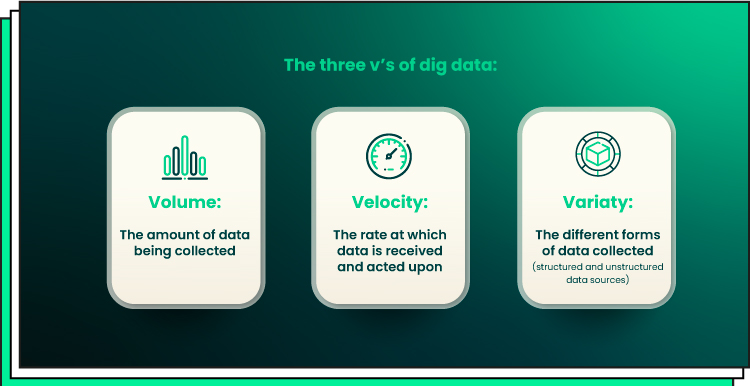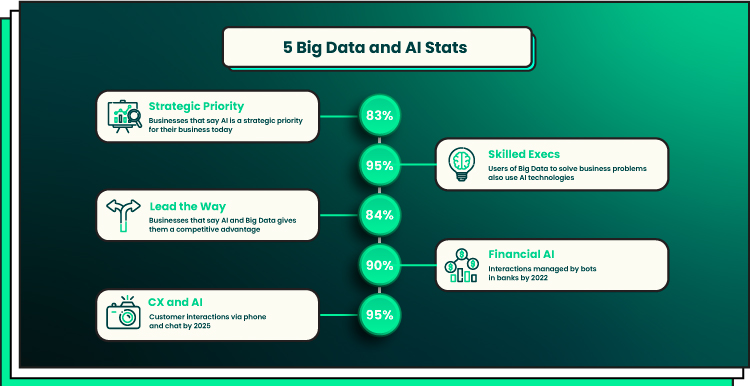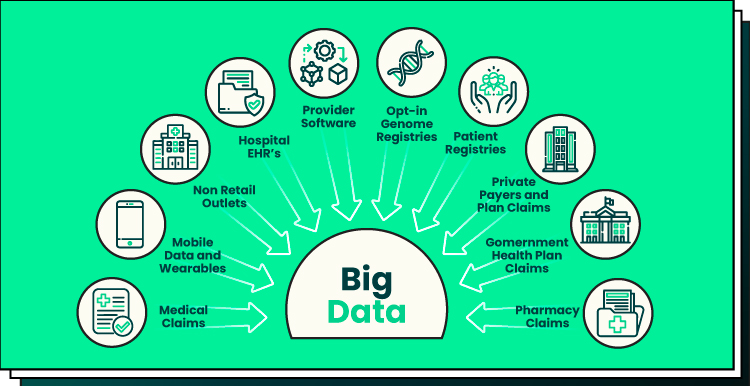In this article, we’ll discuss how Big Data and AI technologies are linked and simultaneously used to produce tremendously productive and useful IT solutions for numerous industries. Also, you’ll learn how to get help with architecting, designing, developing, and testing software systems that employ Artificial Intelligence for Big Data analytics.
In the era of digital transformation, two groundbreaking technologies, Big Data and Artificial Intelligence (AI a.k.a. Cognitive Computing), have emerged as powerful catalysts for innovation across different economic sectors. The term Big Data describes the massive volumes of structured and unstructured data generated by individuals, organizations, and machines, while AI encompasses the development of intelligent systems that can automatically perform tasks that traditionally require a human brain and sophisticated professional skills.
By combining the capabilities of Big Data and AI, businesses can reveal valuable insights, enhance decision-making processes, and drive innovation or reasonable change in ways never imagined before. From this article, you’ll learn more about the intricacies of this tech intersection, exploring the relationship between big data and cognitive computing, their benefits, real-world examples, challenges, and future trends.
Overview of Big Data and Artificial Intelligence: IoT, Computer Vision, Video Surveillance Solutions, and More
Big Data refers to extremely large and entangled datasets, often measured in petabytes, which require specific approaches to be efficiently stored, managed, processed, and analyzed. Because of its enormous size and poor structural organization, Big Data can barely be handled with traditional data-processing methods and conventional applications. Let’s name several common sources and technologies that can generate Big Data:
| Big Data Sources | Specific Examples |
| Internet of Things (IoT) | IoT devices, robots, sensors, wearables, and smart appliances |
| Social Media | Thousands of posts, photos, videos, comments, and likes are left on social media every single moment |
| E-commerce Platforms | Online marketplaces like Amazon and eBay accumulate extensive data on user transactions, deliveries, behavior, feedback, purchase history, preferences, and reviews |
| Machine-generated Data | Transport machinery, self-reliant vehicles, monitoring systems, and industrial equipment of different sizes and types |
| Scientific Research | A great variety of smart scientific instruments used in healthcare, genomics, particle physics, astronomy, pharmaceutical study, and climate science |
| Video Streaming | Video surveillance, robotic vision, non-entertainment AR projects, streaming video platforms like YouTube |
At the same time, Artificial Intelligence (AI) is the second element of this couple. Cognitive computing encompasses the development and implementation of advanced software systems including neural networks that feature the remarkable potential to engage in logic, reasoning, and decision-making processes to support business and other areas of human activities.
These two cutting-edge technologies go beyond mere automation: instead, AI possesses the capacity to be agile, learn, and adapt, like a living being, but also employ powerful techniques such as visual perception, emotion recognition, and language translation. Different cognitive computing models strengthened by Machine Learning (ML) can be used to extract meaningful insights from vast oceans of Big Data, surpassing the efficiency of traditional human-driven methods.
Are AI and Big Data Technologies Affordable for Small & Medium Businesses?
YES. It is astonishing to realize that AI systems have already become an integral part of our daily lives, seamlessly woven into the fabric of our digital interactions. Thanks to a growing number of open-source platforms and cloud services, AI and Big Data solutions are no longer an exclusive privilege of tech giants like Amazon, Google, or Facebook. Smaller companies can now implement and make use of the same high-tech capabilities, too. If you are interested in adopting or building an AI-based application for smart e-commerce marketplaces, fin-tech & banking solutions, or any other industry, contact Forbytes team for consulting!
The Relationship Between Big Data and AI: How These Conceptions Are Combined and Work Together
Big Data and AI are intricately linked, with each technology complementing the other in the context of different IT solutions. Basically, this is how most of these solutions work:
- Big Data provides fuel for AI systems by offering vast amounts of diverse data for training and refining algorithms.
- The abundance of data (usually received and stored in cloud-based repositories) enables AI models to learn patterns via ML applications.
- Then AI applications make accurate predictions or generate valuable insights based on their previous “experience”.
But how are the conceptions of Big Data and AI exactly interrelated and coordinated in IT systems? You can easily understand this concept if you learn about the three key characteristics of Big Data. The major qualities of Big Data (so-called three V’s) include:
- Volume
- Velocity
- Variety
Each of these qualities is a challenge and difficulty in software engineering, which can be successfully handled using Machine Learning and Artificial Intelligence. Let’s learn the details of AI and Big Data in the following sections:

Artificial Intelligence: Big Data’s Velocity Management
To effectively harness the power of Big Data, it must first be captured through high-speed data transmission channels and stored in specialized cloud-based repositories known as Cloud Lakes. This is due to the sheer velocity at which Big Data is generated, often approaching real-time operation. The combination of its colossal volumes and rapid generation poses a significant technical challenge when it comes to capturing and managing Big Data. Once captured, the next crucial step is to preprocess the Big Data, a task that requires the expertise of data science and analytics professionals. This preprocessing phase involves reorganizing the data for further interpretation, which includes data normalization and cleansing.
Normalization ensures that the data is standardized and structured in a consistent manner, enabling meaningful analysis and comparisons. Simultaneously, cleansing the data involves identifying and removing redundancies, errors, artifacts, informational noises, duplications, and other potential data issues that may distort the accuracy and reliability of subsequent analyses. Artificial Intelligence in Big Data systems can be used to receive and automatically prepare data according to specific algorithms and scenarios, so you don’t have to spend countless work hours with costly digital data analysts for manual execution of the same tasks.
Volumes & Variety of Big Data and Artificial Intelligence Solutions to Address Them
Big Data is characterized by its vast datasets, which encompass a variable combination of two distinct elements:
- Structured data represents well-organized clusters of information, typically presented in a predefined format. This includes data types such as numerical values, dates, tables, and categorized information, which can be easily sorted, analyzed, and interpreted.
- Unstructured data comprises massive collections of data without a clear organizational structure. It can take the form of raw text, high-resolution images, videos, and instrumental data generated by interconnected device systems.
Video Surveillance: Example of an AI and Big Data Integrated Solution
Unstructured data poses a significant obstacle to processing because it comes with a large portion of low-value data, which is often considered noise and garbage information as it does not contribute significant value to the organization. A prominent example is video surveillance systems, where vast volumes of data are captured, such as gigabytes and petabytes of similar video recordings displaying repetitive scenes with minor variations, such as the movement of leaves caused by the wind.
However, it is crucial to monitor and swiftly detect any instances of intruders or security breach attempts amidst this sea of data noise. This is where AI can come to the rescue, liberating human security guards from the arduous task of continuously monitoring camera recordings day and night in hopes of identifying potentially suspicious activities. Any time an unusual object or situation is detected, an AI-driven system can immediately alert human operators.
Where else Do Big Data for Artificial Intelligence-driven Processing Originate from?
Unstructured data in business can originate from various sources:
- Marketing studies, where customer-related information is collected from a multitude of social media platforms and web-based sources through parsing techniques.
- IoT systems and robotic solutions in different sectors
- Large-scale corporate IT environments and networks of various types
- Healthcare tech-driven environments with sophisticated devices collecting patient data.
Addressing the challenge of unstructured data is a pivotal point in unlocking the true value and meaning of Big Data. With the advent of the three pillars—Artificial Intelligence, affordable cloud technologies, and Machine Learning—innovative solutions have emerged: AI algorithms can rapidly analyze and interpret unstructured data, extracting valuable insights and patterns from these diverse sources. By harnessing the power of AI, businesses can gain invaluable customer insights from social media data, optimize operations through video analytics, and utilize IoT-generated data to drive informed decision-making.

The Benefits of Using Big Data and AI Together
The combination of Big Data and AI offers a plethora of benefits for businesses that embrace these cutting-edge technologies. This powerful synergy is transforming traditional business operations and propelling organizations toward unparalleled productivity and success. Let’s check the prerequisites for these improved results:
Improved AI-based Decision-Making
The amalgamation of Big Data and AI empowers organizations with improved decision-making capabilities. By mining vast amounts of data and employing cognitive computing for sophisticated AI-powered analytics, businesses can gain access to real-time insights, predictive analytics, and actionable recommendations in the fields of marketing, HR management, technological processes, and manufacturing operations. This enables business executives to:
- Spot potential problems early
- Avoid organizational crises
- Make informed choices
- Optimize workflows
- Identify market trends
- Enhance overall operational efficiency
- Do everything mentioned without doing deep mathematical studies by themselves.
Thanks to the efficient integration of artificial intelligence with Bid Data, gone are the days of relying on gut instincts or managerial expertise alone—data-driven business thinking becomes the guiding light for new strategic initiatives in companies of all sizes and shapes.
Automation and Efficiency
Furthermore, the integration of AI into big data landscapes ushers in a new era of automation and efficiency. Mundane and repetitive tasks that once consumed precious human resources can now be automated through AI-powered systems: this now refers to tasks that previously required the involvement of very expensive specialists, like data analysts. These AI solutions are not a complete substitute for human employees of skilled professions but empower them to do more qualified calculations and research in less time This liberation allows employees to redirect their energy towards higher-value activities that demand critical thinking, creativity, and problem-solving skills. As a result, businesses witness streamlined operations, reduced costs, and improved productivity, as human potential is maximized.
Personalization in Marketing Offerings and Services
Big data and AI open up new avenues for delivering personalized experiences to customers. Through the analysis of vast amounts of customer-related data, including preferences, purchase history, and behavior patterns, AI systems can tailor products, services, and marketing messages to individual needs. This level of personalization:
- Fosters greater customer satisfaction
- Ensures better reaction to your offers
- Helps you build loyalty and long-term engagement.
By deeper understanding the unique preferences and requirements of their customers, businesses can create more well-targeted and precise marketing formulas to hit each segment of their audiences, and thereby build profitable and lasting relationships, creating a competitive advantage in today’s customer-centric landscape.

Real-world Examples of Big Data and AI in Action
The revolutionary power of Big Data and AI has already made a significant impact across a wide range of industries. Here are some noteworthy examples:
Healthcare and Health tech: IBM’s Watson, a prime example of AI in healthcare, utilizes natural language processing and machine learning algorithms to assist doctors in diagnosing complex diseases and recommending personalized treatment options. This advanced technology enables healthcare professionals to access a wealth of medical knowledge base and make more accurate and timely decisions, ultimately improving patient treatment outcomes and reducing medical mistakes.

AI Applications in Banking & Finance: In the financial sector, including banks, insurance providers, and credit unions, companies can leverage the power of Big Data and AI to assess the creditworthiness or financial sustainability of their potential clients. By analyzing extensive datasets comprising credit & transaction history, financial behavior, and various online sources for reputation, AI algorithms can effectively evaluate individuals and businesses for credit or insurance eligibility. This technological advancement enables the provision of inclusive financial services, particularly to underserved populations who have historically encountered obstacles when seeking traditional banking or credit services.
AI Enhancement for Retail & Online Commerce: Retail giant Amazon has transformed the customer experience through the use of AI algorithms. By analyzing customer data, including purchase history, browsing behavior, and demographic information, AI-powered systems can deliver highly personalized product recommendations. This level of personalization enhances customer engagement, increases sales, and cultivates long-term loyalty among current customers as well as helps better convert the leads. Similarly, other retailers or marketplaces have leveraged the combination of Big Data and AI to optimize their approaches in inventory management, pricing management strategies, and supply chain operations.
AI and Big Data Applications in Transportation: The transportation sector can greatly benefit from the implementation of Big Data and AI. For example, ride-hailing companies such as Uber and Lyft utilize AI algorithms to optimize their matching algorithms, ensuring efficient and timely pickups for passengers. Additionally, AI-powered systems are utilized for route optimization, traffic prediction, and driver behavior analysis, leading to improved operational efficiency and enhanced user experiences. Another important field among AI + Big Data applications includes unmanned vehicles and automated logistics for drones, cars with computer vision, and other types of pilotless technologies.
The Challenges and Limitations of Big Data and AI
Ethical and Legal Implications: The intersection of Big Data and AI may bring certain ethical doubts to the forefront. This is related to the concerns of data privacy, security, transparency, workplace ethics, and algorithmic biases. Every point demands careful attention and responsible practices to ensure trustworthy and fair outcomes: At the moment, several national governments have already applied limitations to the scope of cognitive computing, because of scandals with personal data processing, digital rights management abuse, and fears of Leo-Luddism in local societies. One of the possible solutions is Federated Learning, a distributed approach to training AI models across multiple devices or organizations without sharing sensitive data, which will address privacy concerns.
Infrastructure and Scalability Issues: Processing and analyzing massive datasets require robust infrastructure, scalable computing resources, and efficient network capabilities, which may demand considerable investments and increased power consumption. However, cloud infrastructure incorporating ML and AI capabilities is becoming more and more affordable these days, so organizations can save on powerful systems and avoid deploying onsite infrastructure but handle the ever-growing influx of data and accommodate future scalability needs wisely.
Talent Shortage: The demand for skilled professionals in data science, AI, and Big Data analytics surpasses the available talent pool. Organizations face the ongoing challenge of attracting, retaining, and upskilling individuals with the necessary expertise to harness the potential of these technologies. This includes the design, development, and configuration of AI-based applications. However, it’s always possible to hire outsourced IT professionals skilled in Artificial Intelligence systems and Big Data analytics.
Bias and Fairness: AI algorithms are prone to inheriting biases or incorrect learning results from the data they are trained on, potentially leading to unfair or discriminatory outcomes. Mitigating bias and ensuring fairness in algorithmic decision-making creates critical challenges that can be prevented by diverse and representative training data and careful algorithm design. All these aspects can be managed by Forbytes team, contact us to discuss the details.
Conclusion: Join Future Trends and Advancements with Forbytes
The intersection of Big Data and Artificial Intelligence is an explosively evolving landscape with several exciting future trends. Increased adoption of edge computing, where data processing occurs closer to the data source, will enable real-time analysis of IoT systems and deliver rich insights for better business operation and strategizing. Explainable AI, which aims to make smart computing algorithms more transparent and interpretable, will be crucial in building trust and accountability.
Specialized microchips engineered for deep learning algorithms are poised to revolutionize computational power, propelling AI systems to new heights of performance and enabling groundbreaking discoveries across diverse domains. As the journey in the realm of Big Data and AI unfolds, these future trends promise a revolution of knowledge, and transformative capabilities, driving innovation and shaping the future. To become a part of this bright future, contact Forbytes team to discuss the implementation of AI and Big Data technologies in your business.

Our Engineers
Can Help
Are you ready to discover all benefits of running a business in the digital era?

Our Engineers
Can Help
Are you ready to discover all benefits of running a business in the digital era?







